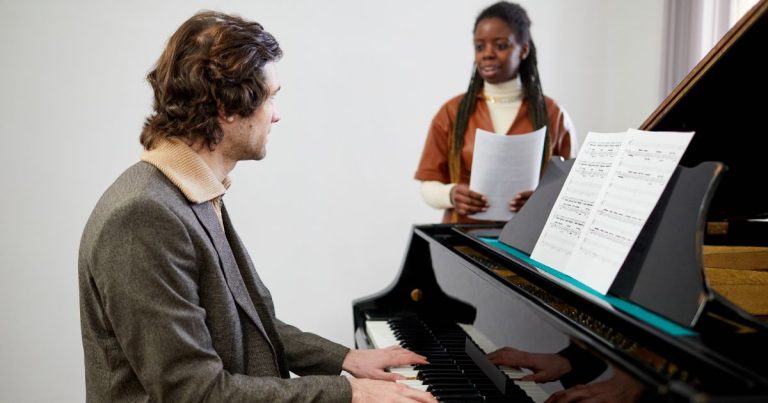Are you in pain after a long day of teaching? Here’s a simple exercise to check if your sitting posture is correct.
As a singing teacher, you no doubt remind your students about the importance of good posture. But do you practise what you preach?
Or are you guilty of slipping into bad habits when you’re working?
As back, neck and shoulder pain can be occupational hazards for singing teachers, it’s important to pay attention to your own posture.
Osteopath Jennie Morton, who has treated many singing teachers, says most issues are caused by teachers spending hours at a piano or keyboard with their heads tilted to one side as they instruct students.
While this setup might be optimal for teaching, it can throw your body’s alignment out.
Jennie suggests this quick exercise to check your sitting posture.
Is Your Posture Correct?
Start by ensuring that you’re sitting on your sitting bones. Many people sit behind their sitting bones, which results in a slightly rounded position.
To find your sitting bones, place your finger in your glute area and bend your knee up. As you bend your knee, you’ll feel those sitting bones pushing downwards.
“They’re the point that you should be sitting on; doing that sets up those neutral spinal curves above it,” Jennie says.
So, how can you know whether you’re in that correct, neutral position?
“First, sit down and then analyse what you have to do to get out of your chair when you stand up. If you’re at a piano, you might need to move the stool away from the piano to do this.
“If you’re in that slightly tucked position—in other words, sitting behind your sitting bones instead of on them—you’re going to have to fling your head forward and do a kind of body ripple to get out of the chair. You have to do this kind of forward-and-back rock to stand up.
“If that’s the case, try again, but tilt your pelvis into more of an arch before you sit.
“As you sit, tilt back and plant those sitting bones directly on the stool. Then, stand up from there.
“If you’ve done that correctly, you can stand up in one movement because your head is over your hips, and there’s nothing to counterweight to heave you up.
“So sit down and stand up. If you did it in one movement, you were in the right position.”
Minimise postural problems
To reduce the risk of back or neck pain while you’re teaching, Jennie recommends:
- Turning your rib cage, not just your head, when looking and talking to students.
- Stretching at the end of the day.
- Taking regular breaks throughout the day. Step away from the keyboard and walk around the room.
Learn more
Tune into the Singing Teachers Talk podcast for more useful advice from osteopath Jennie Morton. In it, Jennie discusses the impact of poor posture and alignment on vocal health.




